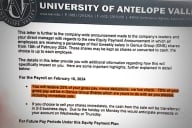You have /5 articles left.
Sign up for a free account or log in.
WASHINGTON -- Democrats in the U.S. Senate are turning up the heat on for-profit colleges for their heavy recruiting of veterans and active-duty service members. But it remains unclear if the strong words on Capitol Hill will translate into policy changes that could slow the flow of military financial assistance to the colleges.
At issue is the $4.4 billion in Post-9/11 G.I. Bill benefits distributed last year by the Department of Veterans Affairs, as well as tuition assistance for service members. For-profit colleges received about $1.6 billion, or 37 percent, of that amount, according to a report released Thursday by the Senate Health, Education, Labor and Pensions Committee. Eight of the 10 institutions receiving the largest amounts are for-profits, and they raked in a combined total of more than $1 billion. Supporters of for-profit colleges have argued that the increases in G.I. Bill funds for the institutions have risen proportionately with overall growth in the G.I. Bill program.
The military tuition-assistance funds do not count as federal financial aid toward the requirement -- known as the "90/10 rule" -- that at least 10 percent of an institution’s funding must be from sources other than federal aid. Many for-profit providers would have problems meeting the standard if G.I. Bill money and Pentagon tuition assistance funds were added toward the 90 percent limit.
Sen. Tom Harkin, an Iowa Democrat, released the report as part of his ongoing scrutiny of for-profits. At a news conference, he said the exclusion of G.I. Bill money from the 90/10 rule was a “technicality” that for-profit colleges had aggressively exploited. Joining Harkin at the event was Sen. Tom Carper, a Delaware Democrat, who said a policy fix was on the way. “We’ll see bipartisan legislation this year to make sure it’s a 90/10 rule.”
Later in the day Carper held a hearing on the issue before the subcommittee of the Senate Committee on Homeland Security and Government Affairs. But no specific proposals appear likely to emerge any time soon, as Carper said he was on a fact-finding mission and suggested a follow-up round table discussion.
An official with the Department of Veterans Affairs said during the hearing that “there is an argument” for including the military tuition money toward the 90 percent limit. But Curtis Coy, the department’s deputy under secretary for economic opportunity, also urged caution, saying such a move would be a “sea change” that could have an impact on both for-profits and their military students.
Giving a boost to the Hill events was an op-ed in Thursday’s New York Times by Hollister K. Petraeus, assistant director for servicemember affairs at the Consumer Financial Protection Bureau and the wife of David H. Petraeus, director of the C.I.A. and the former commander of U.S. forces in Iraq and Afghanistan. Petraeus was critical of “questionable marketing” by some for-profit colleges in the article, and called for the G.I. Bill money to count toward 90/10.
Several veterans groups are backing that call, including Veterans for Foreign Wars of the United States, as are groups that advocate for students generally. Carper, however, said repeatedly that not all for-profit institutions deserve criticism for how they treat veterans and active-duty students. One of the “white hats” he singled out was the American Public University System, which serves a large number of military students.
During the hearing, Russell Kitchner, the system’s vice president for regulatory and governmental relations, said he opposed adding veterans’ benefits to the 90/10 rule. He said many colleges would be forced to raise tuition to meet that tougher 90 percent requirement.








